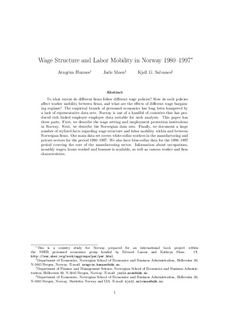Wage structure and labor mobility in Norway 1980–1997
Working paper
Permanent lenke
http://hdl.handle.net/11250/163587Utgivelsesdato
2005Metadata
Vis full innførselSamlinger
- Discussion papers (FOR) [566]
Sammendrag
To what extent do different firms follow different wage policies? How do such policies affect worker mobility between firms, and what are the effects of different wage bargaining regimes? The empirical branch of personnel economics has long been hampered by a lack of representative data sets. Norway is one of a handful of countries that has produced rich linked employer–employee data suitable for such analysis. This paper has three parts. First, we describe the wage setting and employment protection institutions in Norway. Next, we describe the Norwegian data sets. Finally, we document a large number of stylized facts regarding wage structure and labor mobility within and between Norwegian firms. Our main data set covers white-collar workers in the manufacturing and private sectors for the period 1980–1997. We also have blue-collar data for the 1986–1997 period covering the core of the manufacturing sector. Information about occupations, monthly wages, hours worked and bonuses is available, as well as various worker and firm characteristics.
Utgiver
Norwegian School of Economics and Business Administration. Department of Finance abd Management ScienceSerie
Discussion paper2005:3
